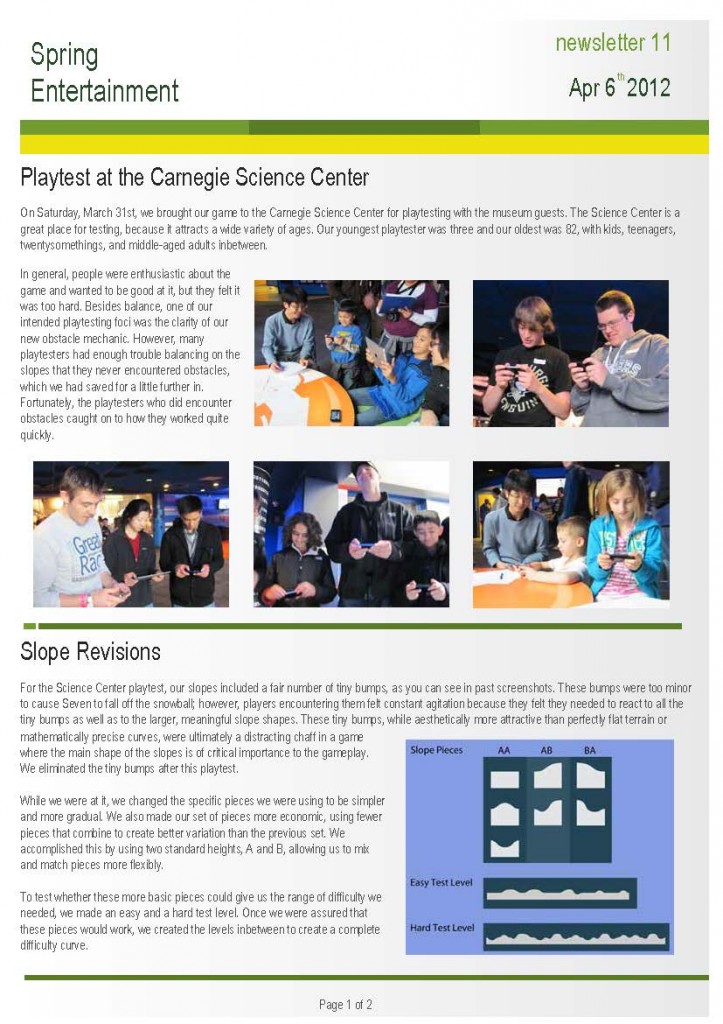Newsletter #11
Playtest at the Carnegie Science Center
On Saturday, March 31st, we brought our game to the Carnegie Science Center for playtesting with the museum guests. The Science Center is a great place for testing, because it attracts a wide variety of ages. Our youngest playtester was three and our oldest was 82, with kids, teenagers, twentysomethings, and middle-aged adults inbetween.
In general, people were enthusiastic about the game and wanted to be good at it, but they felt it was too hard. Besides balance, one of our intended playtesting foci was the clarity of our new obstacle mechanic. However, many playtesters had enough trouble balancing on the slopes that they never encountered obstacles, which we had saved for a little further in. Fortunately, the playtesters who did encounter obstacles caught on to how they worked quite quickly.
Slope Revisions
For the Science Center playtest, our slopes included a fair number of tiny bumps, as you can see in past screenshots. These bumps were too minor to cause Seven to fall off the snowball; however, players encountering them felt constant agitation because they felt they needed to react to all the tiny bumps as well as to the larger, meaningful slope shapes. These tiny bumps, while aesthetically more attractive than perfectly flat terrain or mathematically precise curves, were ultimately a distracting chaff in a game where the main shape of the slopes is of critical importance to the gameplay. We eliminated the tiny bumps after this playtest.
While we were at it, we changed the specific pieces we were using to be simpler and more gradual. We also made our set of pieces more economic, using fewer pieces that combine to create better variation than the previous set. We accomplished this by using two standard heights, A and B, allowing us to mix and match pieces more flexibly.
To test whether these more basic pieces could give us the range of difficulty we needed, we made an easy and a hard test level. Once we were assured that these pieces would work, we created the levels inbetween to create a complete difficulty curve.
Collectibles and Speed Boost
In the middle of the week, we integrated collectible objects (depicted as dog biscuits), which Seven can pick up when rolling on the snowball or jumping in the air. These will contribute to the player’s score and will provide some quick rewards with juicy feedback.
There is also now a special power-up which grants Seven a temporary speed boost. This power-up replaces one aspect of our revised speed mechanic, a so-called bonus force, which had been intended to create large variations in speed. We weren’t getting the effect we wanted and it was hard for the player to control, so we’ve simplified things with the power-up. This makes it easier for players to see a sharp contrast in speed and the source of that speed so they can make more meaningful choices.
Second Internal Playtest
We ended our week with a Friday morning playtest with other ETC students, in order to try out the new mechanics we had implemented as well as to get more feedback about the difficulty of the game. It’s a high priority for us to eliminate all the frustrating things that make the game difficult in a bad way, while retaining and enhancing positive sources of excitement and challenge. Here are some of the key playtest results:
- Our revised slopes are more playable than the ones used at the Carnegie Science Center. With the elimination of tiny bumps, players seemed to move the phone less haphazardly and more deliberately in reaction to the slopes.
- The difficulty curve ramps up too fast. We still need even easier slopes for the first environment, and we need to adjust some of our obstacle and collectible placement.
- Especially with the simpler slopes, the tilt controls may now be a little oversensitive.
- Sometimes, when descending, the camera doesn’t catch up with the player fast enough, making it difficult to see upcoming slopes.
- Obstacles need to be made a little bigger and their colors should pop from the background more.
- The sense of accomplishment is hampered by a lack of certain upcoming features, such as randomized levels, scoring, and achievements.
- The speed boost was popular, though most people would like to be invincible while it is in effect.
- The mechanics seem solid and most feature requests now pertain to other areas (achievements, indications of progress).

